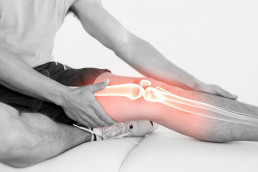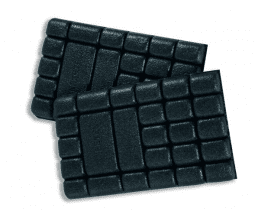Knee pads are indispensable when your work puts intensive strain on your knees. Failure to protect your knees could result in the consequences of any injuries and wear on your knees staying with you your entire life. Knee pads provide the necessary protection for the knee joint not only for tradespeople, such as tile and floor layers, but also for amateur gardeners or DIY enthusiasts. But what should you look for in a knee pad? In this blog post, we explain the anatomy of your knee and tell you everything you need to know about knee pads.
The anatomy of the knee
The knee is one of the largest and most complex joints in the body. The knee joint connects the femur, the shin and the knee cap. The complex ligament system and joint cartilage ensure smooth and painless movement of the knee joint. Menisci, ligaments, tendons and muscles stabilise the leg and execute the movements. Between the femur and the shin are the inner and outer menisci, which act as shock absorbers and sliding bearings for the knee joint. The cruciate ligaments as well as the inner and outer collateral ligaments stabilise the knee joint and are supplemented by the patella tendon, in which the knee cap is embedded. In a healthy person, the contact surfaces of the bones in the knee joint are protected by a cartilage layer. Age and strain-related wear of the cartilage layers is reduced by a joint fluid produced in the joint capsule. The interaction of tendons, ligaments, menisci and an intact cartilage layer is crucial for painless movement of the knee joint.

Knee injuries
Most people only become aware of the important function of bending and stretching the leg at the knee joint when it no longer works smoothly due to a knee injury or wear of the joint. According to statistics from the OSINSTITUT, 223,098 people were given in-patient treatment in German hospitals in 2019 due to knee and lower leg injuries. Damage to the cruciate ligaments and collateral ligaments, cartilage and meniscus damage are among the most frequent conditions. Bursitis and gonarthrosis are among the other conditions caused by private and professional kneeling activities.
Torn ligament in the knee
A torn ligament is one of the most common knee injuries. A ligament strain or torn ligament is often caused by excessive strain on the knee. These fibre strands, which are not very elastic, stabilise the knee joint during movements. If torn completely or partially, the damaged ligaments cause instability of the joint.
Meniscus injury
Another common cause of knee complaints is meniscus injuries. The inner and outer menisci stabilise the knee joint and cushion the interstitial spaces in the knee. A meniscus injury can be caused by wear or excessive twisting of the knee, which has caused cracks and tears in the menisci.

Knee protectors: Which knee pads are the right ones?
In particular if the knee is put under a lot of strain during your work, you should use knee protectors to prevent symptoms and strain. But not every knee pad is suitable for every purpose. While tradespeople often spend many hours in an unnatural work posture several days in a row, DIY enthusiasts and amateur gardeners will usually only work for a shorter period of time. That’s why, when buying knee protectors, it is important to check which requirements the product meets.
In particular, in relation to personal protective equipment, you should note standard/guide DIN EN 14404 when buying knee pads. If this is specified, the knee pads meet the following criteria: They are puncture resistant and made from a safe and watertight material.
Type 1 of this standard is a knee pad that is secured on the leg independently of other clothing. Type 2 knee protectors involve a pad that is inserted in a designated pocket on the trouser leg of a certified pair of trousers. The third type is a knee protection device that is not worn directly on the body. Type 4 knee protectors are part of a unit with additional functions.
In addition, there are three performance classes of knee protectors:
Performance class 0 offers low protection and is therefore suited to kneeling work on flat surfaces. Note that knee pads in this performance class offer no protection against penetration.
Performance class 1 is designed both for flat and uneven surfaces and offers protection against penetration by a force of (100 ±5) N. This type of protection is recommended, for example, when laying floor coverings, such as tiles, parquet or paving stones as well as for gardening work outdoors. Because even the surface elevations of a lawn or flower bed can damage a knee that is not adequately protected.
Knee protectors in performance class 2 have properties that meet the requirements of work in severe conditions. With this class, the protection against penetration increases compared to the first two classes, to a force of at least (250 ±10) N. This guarantees safe protection of the knee even when working with broken or detonated materials, such as in mining.

Protecting knees – Functionality meets comfort
Of course, the wearer comfort of the knee pads is also crucial. Because if they are not comfortable, restrict movement or leave pressure points, they will more often be taken off than actually worn.
That’s why knee pads must not only ensure adequate protection, but must also be comfortable to wear and easy to handle. Multipad knee pads combine the requirements of knee protectors for work in a kneeling position with a high level of wearer comfort. The knee pads not only meet the DIN EN 14404 standard, but also fit equally well on the left and right knee so that there is no risk of confusion. They are therefore ideal for laying floor coverings and tiles, demolition and dismantling work and even work in a smithery, plumbing, air conditioning and heating installation or in road construction.
What do you and your employees wear to protect your knees? Tell us about your field of work and the type of knee protection that is used there. You can also discover our extensive range of uvex trousers with kneepad pockets. We are happy to provide detailed advice about our products.